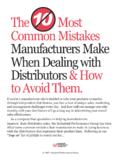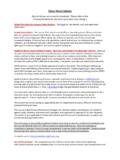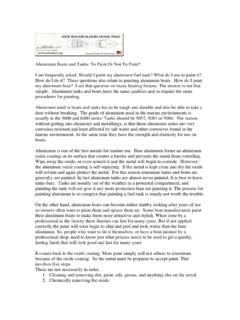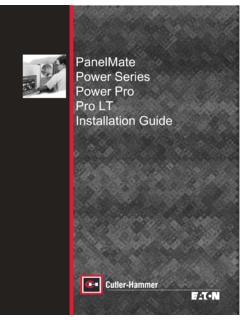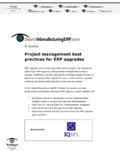Transcription of THE 16 COMMON MISTAKES, A PREVENTATIVE …
1 THE 16 common mistakes , A PREVENTATIVE guide By David Klaus Director, Briggs Racing The 206 crate engine is built from a dedicated platform engineered and designed for racing. Even engineered for a brutal environment and built by hand to assure the highest level of craftsmanship, the experience you have still comes down to making the right choices. This simple guide is intended to help you navigate through the most COMMON mistakes so that you can enjoy what racing is all about! The COMMON mistakes that a racer makes: 1. Not setting the float level upon first installing your engine resulting in poor engine performance. After our labor of love leaves us your local parcel carrier will push, shove, and possibly even drop your engine changing the factory float setting in your carburetor. Float height is critical to engine performance as it controls the amount of fuel in your carburetor bowl by controlling the opening and closing of the inlet needle (fuel supply from your fuel pump).
2 Too much fuel can cause bogging or a sluggish throttle response. Whereas not enough fuel will elevate your engine operating temperatures and top end performance will suffer as the engine starves for fuel. On our website, , we have a video tutorial on how to set your float height. Also under the documents tab of our 206 section is a carburetor tuning guide . Print this out and put it in your toolbox. The PZ carburetor is a very easy to tune but knowledge is power so please take the time to read and understand. 2. Using the wrong choice of oil which can leads to premature wear, internal rust, and even failure. The choice of oil you use will play one of the largest roles in the performance and longevity of your engine. We recommend using only Briggs & Stratton 4T synthetic racing oil as it was specifically engineered for your race engine. 4T is readily available through any Amsoil or BriggsRacing dealer.
3 Do not: o Use karting oils as many are simply a compressor lubricant and food coloring. They offer very limited protection, are prone to water contamination, and have a TBN of zero. This base oil is not used in any other form of racing and/or combustion engine because of these severe limitations. o Use car or race oils designed for automotive use. This category of oil is engineered for pressure lube systems. When used in a splash lube system they tend to foam/froth greatly reducing their ability to protect. In addition, automotive oils are engineered for the lower operating temperatures of a liquid cooled verses air cooled environment. Page 1 3. Allowing your clutch to float WILL lead to crankshaft damage. Clutch manufacturers offer generic recommendations not necessarily knowing what engine or application their clutches will be used on. Allowing the clutch to float on your 206 engine will overloads the keyway (too much torque spread over too small of surface area) and will result in keyway damage.
4 Our crankshaft is carbon steel and even so the design of most clutches offer an insufficient surface area to transfer load. In order to prevent keyway damage the clutch hub HAS to be locked against the shoulder of the crankshaft. We have a video on on how to properly installing your clutch. 4. Installing your exhaust system in a bind which can result in either the bracket or exhaust pipe failure. When installing your exhaust always start with the cylinder head fasteners first. IF the brace does not fit flat against the cylinder head mounting boss use the washers provided to take up the space and or bend the brace carefully to fit flush. If any excess force is used installing the brace and/or exhaust fasteners this WILL over stress the exhaust system leading to breakage and/or the exhaust fasteners at the head to strip out. Bringing each fastener to final torque will naturally create a bind.
5 Take your time and do not use the force of an impact to make the exhaust fit . Slowly work to final torque by alternating fastener torque in steps, increasing torque in stages. 5. Overwrapping your exhaust system. Sanctioning bodies mandate that your header system be wrapped with an approved exhaust material. When installing wrap it is important to make sure that you do not double wrap or excessively overlap of this material. This will insulate the exhaust trapping in excessive heat which can impact the strength and life of your exhaust. Do not start your header wrap until 3 inches above where the flange meets the cylinder head. Wrapping closer to the flange will trap heat elevating head temperatures that could lead to exhaust valve seat warping and/or head gasket failure. 6. Not checking valve lash after the initial break-in period. After your engine goes through several heat cycles valve lash has a tendency to grow as component stresses from manufacturing are relieved.
6 We recommend that lash is checked during the first 30-60 minutes of initial run time. We have a video on on how to set your valve lash. 7. Running at the rev limiter in slide restricted classes. When air is restricted an engine s peak torque and horsepower occur earlier in the power band. The greater the restriction, the lower in the rpm range peak horsepower and torque will occur. Peak horsepower for the unrestricted 206 is around 5,600 rpm whereas the Green slide restrictor peak horsepower is at 4,800 rpm. Gearing past 5,300 rpm, given that the peak is 4,800 rpm with a Green slide, will result in slower lap times. Gear for the power band, not the rev limiter. Page 2 8. Using a aluminum offset motor mount plate and offsetting the motor mount plate too far. Excessively offsetting an engine offers very little engine stability and amplifies vibration by acting as a springboard.
7 Engine stresses compound as the natural engine motion (which we have engineered for) falls on one plane, the flexing of the chassis on multiple planes, and your engine s crankshaft load changes as chain tension varies as your chassis flexes. Install the engine with no more than a inch offset. When a typical inch plate is used and offset beyond , strain gauge tests shows up to a 20% increase in vibration measured at the valve cover. This is a TREMDOUS amount of additional vibration without taking into account any COMMON additional sources of vibration (track surface, tire balance, bent axles, etc.). Vibration accelerates fatigue causing component failure and fastener torque loss. Just because an engine mount allows for a greater offset doesn t mean you should do it! The greater the offset the more harmonics and stress on your engine block and side cover.
8 Most inch aluminum engine mounting plates are also machined for weight reduction allow even greater flex as the very rigidity needed is stripped away to save an ounce. Use a QUALITY mount. The BEST on the market is the Odenthal mount. It allows for greater offset without sacrificing rigidity. Another system would be the PMI engine mount with the engine plate verses the standard plate. Typically we would not offer brand recommendations but the foundation that your engine sits on is critical to success. 9. Not oiling your Green air filter before using. Your Green air filter is a premium filter that uses oil to effectively trap and prevent debris from entering your engine. It must be oiled before initial use (it shipped dry) and we recommend using Green air filters oil recharging system. For instructions on how to clean and oil your air filter please check out Your oil filter is your only barrier to preventing debris from entering your engine.
9 This is one of the BEST filters available but it needs to be properly oiled in order to offer you the best protection possible. 10. Not installing a fuel filter. Your fuel source has dirt in it, your tank has dirt in it, and installing a fuel filter will prevent debris from entering your carburetor where it can clog a jet or prevent proper fuel delivery. All of which usually happens during a race as you agitate your fuel. Page 3 11. Not properly storing your engine. Today s fuel has ethanol in it. Ethanol is corrosive and attracts water. Left in your carburetor over a period of time it will form zinc and aluminum oxide as it reacts with the materials around it. Aged fuel will also varnish on carburetor parts over time. With some simple steps this mess can be prevent. o Fuel stabilizer Check to make sure the addition of stabilizer (specific to ethanol fuel) does not impact the approach that your track or series uses to tech fuel.
10 O After an event remove the fuel line feed at the pump, open up your bottom bowl drain, and let gravity remove all the fuel into an approved fuel gas. Retighten your drain screw and take some WD-40 and spray it into your fuel line. Use enough so that it drains into your carburetor and coats internal parts for protection. Reinstall and secure your fuel line to the pump. o If you are done for the season I would follow this same process AND leave Briggs 4T in your crankcase. Most karting oils attract water and leaving them in your engine over a winter will cause rust and acid etching. Acid formation is a by-product of combustion that gets past the rings combining with water attracted by PAG based karting oils. Briggs 4T has a high TBN (ability to neutralize engine combustion by-products) along with a premium rust inhibitor. o As we are talking about fuel please use all safety precautions and only perform pickling your engine after it has cooled down and away from any ignition sources.
